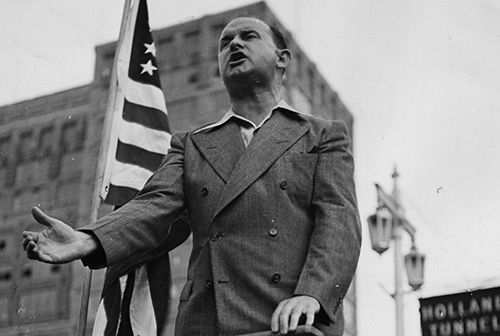
On this date 80 years ago, in 1935, Transport Workers Union (TWU) president Mike Quill and four of his union colleagues were jumped by thugs at Grand Central Station as they made their way to union headquarters after picketing the Interborough Rapid Transit Company (IRT) offices in lower Manhattan. Not so strangely, given the intense polarization between labor and capital in the 1930s, this led to Quill and the others – Herbert C. Holmstrom, Thomas H. O’Shea, Patrick McHugh and Serafino Machado – being arrested for inciting a riot. Hundreds of TWU members descended on a New York City courthouse, offering their own money to bail out their leaders.
The charges were quickly dismissed by the court, but the incident was retold in the media and at every work location, where it epitomized and typified the cumulative history of abuses suffered by transit workers throughout the city. This militant defense helped establish the union’s reputation.
There had been earlier attempts at subway worker organizing in 1905, 1910, 1916 and 1919, and 1926, generally along craft lines, but they were crushed by the transit companies’ use of “beakies,” hired goons who intimidated and violently attacked any who opposed the transit companies. The TWU, founded in 1934, then expanded to represent transit employees in other cities, primarily in the eastern U.S. Its largest local, Local 100, represents the transport workers of New York City. The TWU is a member of the AFL-CIO.
The transport workers set the pace for militancy and left-wing politics. It was one of the first unions to join the Congress of Industrial Organizations.
When the TWU began organizing, two of the three NYC subway systems were privately owned and operated. Most workers on the IRT and the Brooklyn-Manhattan Transit Corporation (BMT) were represented by company unions, while the Brotherhood of Locomotive Engineers and the Brotherhood of Railway Signalmen represented small pockets of skilled workers on the BMT.
When the Great Depression hit, public and private management took advantage of high unemployment rates by offering jobs to anyone willing to accept excessively low wages, brutal management practices, and poor working conditions. With a national unemployment rate reaching 25 percent, there were nearly 20,000 applicants for every job in the transit industry.
Pay cuts of ten percent by both the IRT and the BMT, along with the layoff of thousands of employees and a speedup of work for those who remained, spurred new organizing efforts in 1932. Many of the Irish subway workers who belonged to Irish nationalist organizations inspired by the socialism and trade union work of James Connolly approached the Communist Party, which had already begun organizing among transit workers. John Santo and Austin Hogan, Trade Union Unity League (TUUL) organizers, met with the Irish workers in a cafeteria at Columbus Circle on April 12, 1934. The name that they chose for the new union was a tribute to the Irish Transport and General Workers Union led by Jim Larkin and Connolly twenty years earlier.
The new organization, founded during the CPUSA’s “ultrarevolutionary” phase that preceded the Popular Front era, focused both on organizing workers into the union and recruiting members for the party through mimeographed shop papers with titles such as “Red Shuttle” or “Red Dynamo.” The new union appointed Thomas H. O’Shea – who would later become a witness against it during the McCarthy period – as its first president.
The TWU proposed to represent all public transit workers in the city, regardless of craft, and campaigned to reverse the wage cut, increase wages to meet increases in the cost of living, limit the workweek to forty hours, and hire more workers to eliminate the speedup and to establish safe and sanitary working conditions.
One worker in that early phase, Michael J. Quill, quickly attained leadership in the fledgling organization. Willing to accept identification as a union activist, he spread the word about the new union by handing out flyers and delivering soapbox speeches in front of company facilities. His abilities in public speaking and playing to the media boosted his effectiveness and the overall draw of the union.
After a year of organizing, the union changed course when Santo and Hogan of the TUUL directed O’Shea and Quill to abandon efforts to form a new union and to run instead for office in the IRT company union, the Interborough Brotherhood. Although Quill denounced the plan at first, he came around and began attending Brotherhood meetings, while still recruiting workers there to join the TWU.
TWU members succeeded, in fact, in turning Brotherhood meetings into a platform for the new emerging union. The first significant strike by the newly formed TWU took place on July 9, 1935, the so-called Squeegee Strike. Management at the Jerome Avenue barn in the Bronx attempted to make the cleaning crews work faster by forcing the use of a 14-inch squeegee instead of the customary 10-inch tool. When six car cleaners were fired for insubordination, a two-day walkout inspired by the TWU caused management to acquiesce and reinstate the workers.
As the union grew, especially after the August 10 Grand Central Station incident, the Communist Party began taking a far less visible role, retiring its militant shop papers after workers complained that they were hurting the union’s organizing drive. Communist Party members still provided much of the leadership for the union, but more quietly.
In the Cold War era, TWU president Quill renounced his former Communist allies, avoiding expulsion from the CIO.
The TWU went on to representing airline, Amtrak, Conrail, and several other categories of transport workers.
Adapted from twu.org and Wikipedia.
Photo: Mike Quill, President and founder of the TWU, stood on top of a soapbox as he held a shop gate meeting outside of the IRT Powerhouse on 59th St. in New York City in 1937. | twulocal100.org/










